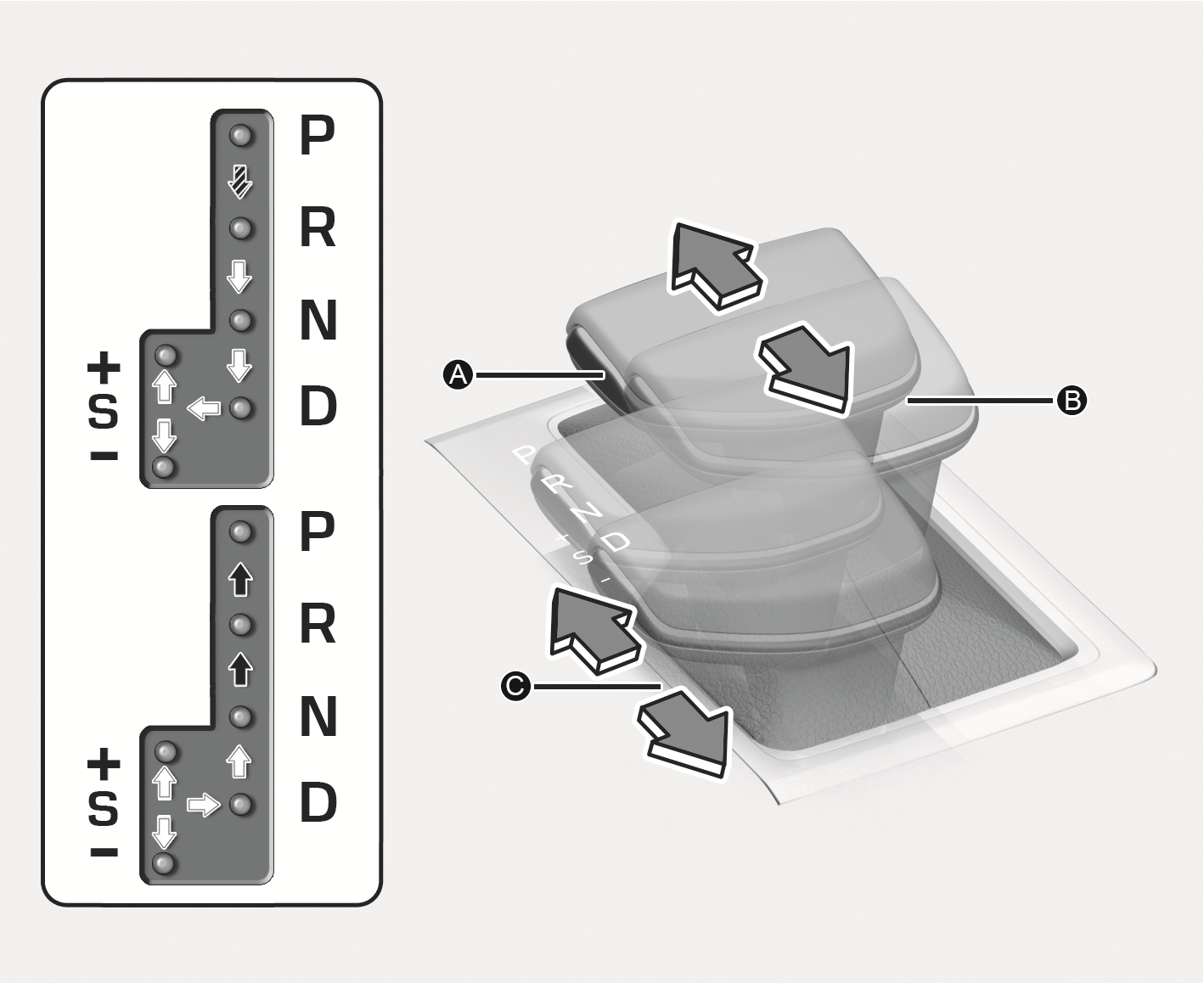Automatic transmission operation (Shift lever type)
The automatic transmission has eight forward speeds and one reverse speed.
The individual speeds are selected automatically in the D (Drive) position.

1C_AutomaticTransmissionLeftOverview
- Shift lever
- Shift release button
- Manual shift mode
 : Depress the brake pedal and press the Shift release button while moving the shift lever.
: Depress the brake pedal and press the Shift release button while moving the shift lever.
 : Press the Shift release button while moving the shift lever.
: Press the Shift release button while moving the shift lever.
 : The shift lever can freely operate.
: The shift lever can freely operate.
To reduce the risk of serious injury or death:
-
ALWAYS check the surrounding areas near your vehicle for people, especially children, before shifting a vehicle into D (Drive) or R (Reverse).
-
Before leaving the driver's seat, always make sure the vehicle is shifted to the P (Park) position, then apply the parking brake, then place the ignition switch to the LOCK/OFF position. Unexpected and sudden vehicle movement can occur if these precautions are not followed.
-
Do not use engine braking (shifting from a high gear to lower gear) rapidly on slippery roads. The vehicle may slip causing an accident.
The indicator in the cluster displays the shift lever position when the ignition switch is in the ON position.
P (Park)
Always come to a complete stop before shifting into P (Park).
The shift lever must be in P (Park) before turning the engine off.
-
Shifting into P (Park) while the vehicle is in motion may cause you to lose control of the vehicle.
-
After the vehicle has stopped, always make sure the shift lever is in P (Park), apply the parking brake, and turn the engine off.
-
Do not use the P (Park) position in place of the parking brake.
R (Reverse)
Use this position to drive the vehicle backward.
Always come to a complete stop before shifting into or out of R (Reverse). You may damage the transmission if you shift into R (Reverse) while the vehicle is in motion.
N (Neutral)
The wheels and transmission are not engaged.
Use N (Neutral) if you need to restart a stalled engine, or if it is necessary to stop with the engine running. Shift into P (Park) if you need to leave your vehicle for any reason.
Always depress the brake pedal when you are shifting from N (Neutral) to another gear.
Do not shift into gear unless your foot is firmly on the brake pedal. Shifting into gear when the engine is running at high speed can cause the vehicle to move very rapidly. You could lose control of the vehicle and hit people or objects.
D (Drive)
This is the normal forward driving position. The transmission automatically shifts to the optimal gear ratio, providing better fuel efficiency and a smoother ride.
For extra power when passing another vehicle or driving uphill, depress the accelerator further until you feel the transmission downshift to a lower gear.
The DRIVE MODE switch, located on the shift lever console or center facia, allows the driver to switch from ECO mode, NORMAL mode to SPORT mode.
For more information, refer to the "Drive mode integrated control system" section later in this chapter.
Manual shift mode

2C_ShiftButtonOverview_2
- Push the lever forwards once to shift up one gear.
- Pull the lever backward once to shift down one gear.
Whether the vehicle is stationary or in motion, manual shift mode is selected by pulling the shift lever from the D (Drive) position into the manual gate. To return to D (Drive) range operation, push the shift lever back into the main gate.
In Manual shift mode, moving the shift lever backwards and forwards allow you to select the desired range of gears for the current driving conditions.
-
Only the eight forward gears can be selected in Manual shift mode. To reverse or park the vehicle, move the shift lever to the R (Reverse) or P (Park) position as required.
-
Downshifts are made automatically when the vehicle slows down. When the vehicle stops, 1st gear is automatically selected.
-
When the engine RPM approaches the red zone the transmission upshifts automatically.
For your safety, the automatic transmission has a shift-lock system which prevents shifting the transmission from P (Park) into R (Reverse) or D (Drive) unless the brake pedal is depressed.
To shift the transmission from P (Park) into R (Reverse):
-
Depress and hold the brake pedal.
-
Start the engine or place the ignition switch in the ON position.
-
Move the shift lever.
-
Shift gear to N (Neutral) after battery jump-start
You cannot shift gears, when the battery is discharged. In emergencies, do the following to shift the gear to N (Neutral) on level ground.
-
Connect the battery cables from another vehicle or from another battery to the jump-starting terminals inside the engine compartment.
For more information, refer to the "Jump starting" section in chapter 8.
-
Apply the parking brake with the ignition switch in the ON position.
-
Shift the gear to the N (Neutral) position.
-
-
Shift gear to N (Neutral) when there are difficulties in battery jump-start

2C_ShiftButtonOverview_3
-
Pull the boot on the shift lever to remove it from the console.
-
Shift the lever to N (neutral) while pressing the button (1) on the back of the rod.
When removing the boot of the shift lever, be careful not to damage the cover.
-
If the vehicle has the symptoms below, have the vehicle inspected by an authorized HYUNDAI dealer.
-
When the Shift Lock does not work
-
When the shift lever does not move from the P (Park) to the R (Reverse) even though the brake pedal is depressed with the engine running